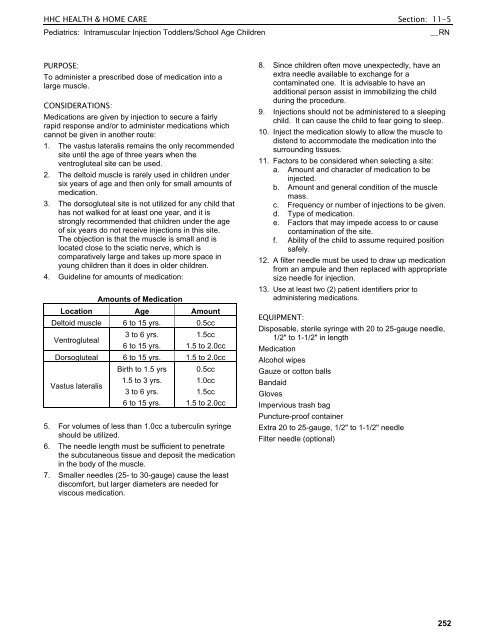HHC Health & Home Care Clinical Policy And
HHC Health & Home Care Clinical Policy And
HHC Health & Home Care Clinical Policy And
Create successful ePaper yourself
Turn your PDF publications into a flip-book with our unique Google optimized e-Paper software.
<strong>HHC</strong> HEALTH & HOME CARE Section: 11-5<br />
Pediatrics: Intramuscular Injection Toddlers/School Age Children __RN<br />
PURPOSE:<br />
To administer a prescribed dose of medication into a<br />
large muscle.<br />
CONSIDERATIONS:<br />
Medications are given by injection to secure a fairly<br />
rapid response and/or to administer medications which<br />
cannot be given in another route:<br />
1. The vastus lateralis remains the only recommended<br />
site until the age of three years when the<br />
ventrogluteal site can be used.<br />
2. The deltoid muscle is rarely used in children under<br />
six years of age and then only for small amounts of<br />
medication.<br />
3. The dorsogluteal site is not utilized for any child that<br />
has not walked for at least one year, and it is<br />
strongly recommended that children under the age<br />
of six years do not receive injections in this site.<br />
The objection is that the muscle is small and is<br />
located close to the sciatic nerve, which is<br />
comparatively large and takes up more space in<br />
young children than it does in older children.<br />
4. Guideline for amounts of medication:<br />
Amounts of Medication<br />
Location Age Amount<br />
Deltoid muscle 6 to 15 yrs. 0.5cc<br />
Ventrogluteal<br />
3 to 6 yrs.<br />
6 to 15 yrs.<br />
1.5cc<br />
1.5 to 2.0cc<br />
Dorsogluteal 6 to 15 yrs. 1.5 to 2.0cc<br />
Vastus lateralis<br />
Birth to 1.5 yrs<br />
1.5 to 3 yrs.<br />
3 to 6 yrs.<br />
6 to 15 yrs.<br />
0.5cc<br />
1.0cc<br />
1.5cc<br />
1.5 to 2.0cc<br />
5. For volumes of less than 1.0cc a tuberculin syringe<br />
should be utilized.<br />
6. The needle length must be sufficient to penetrate<br />
the subcutaneous tissue and deposit the medication<br />
in the body of the muscle.<br />
7. Smaller needles (25- to 30-gauge) cause the least<br />
discomfort, but larger diameters are needed for<br />
viscous medication.<br />
8. Since children often move unexpectedly, have an<br />
extra needle available to exchange for a<br />
contaminated one. It is advisable to have an<br />
additional person assist in immobilizing the child<br />
during the procedure.<br />
9. Injections should not be administered to a sleeping<br />
child. It can cause the child to fear going to sleep.<br />
10. Inject the medication slowly to allow the muscle to<br />
distend to accommodate the medication into the<br />
surrounding tissues.<br />
11. Factors to be considered when selecting a site:<br />
a. Amount and character of medication to be<br />
injected.<br />
b. Amount and general condition of the muscle<br />
mass.<br />
c. Frequency or number of injections to be given.<br />
d. Type of medication.<br />
e. Factors that may impede access to or cause<br />
contamination of the site.<br />
f. Ability of the child to assume required position<br />
safely.<br />
12. A filter needle must be used to draw up medication<br />
from an ampule and then replaced with appropriate<br />
size needle for injection.<br />
13. Use at least two (2) patient identifiers prior to<br />
administering medications.<br />
EQUIPMENT:<br />
Disposable, sterile syringe with 20 to 25-gauge needle,<br />
1/2" to 1-1/2" in length<br />
Medication<br />
Alcohol wipes<br />
Gauze or cotton balls<br />
Bandaid<br />
Gloves<br />
Impervious trash bag<br />
Puncture-proof container<br />
Extra 20 to 25-gauge, 1/2" to 1-1/2" needle<br />
Filter needle (optional)<br />
252







